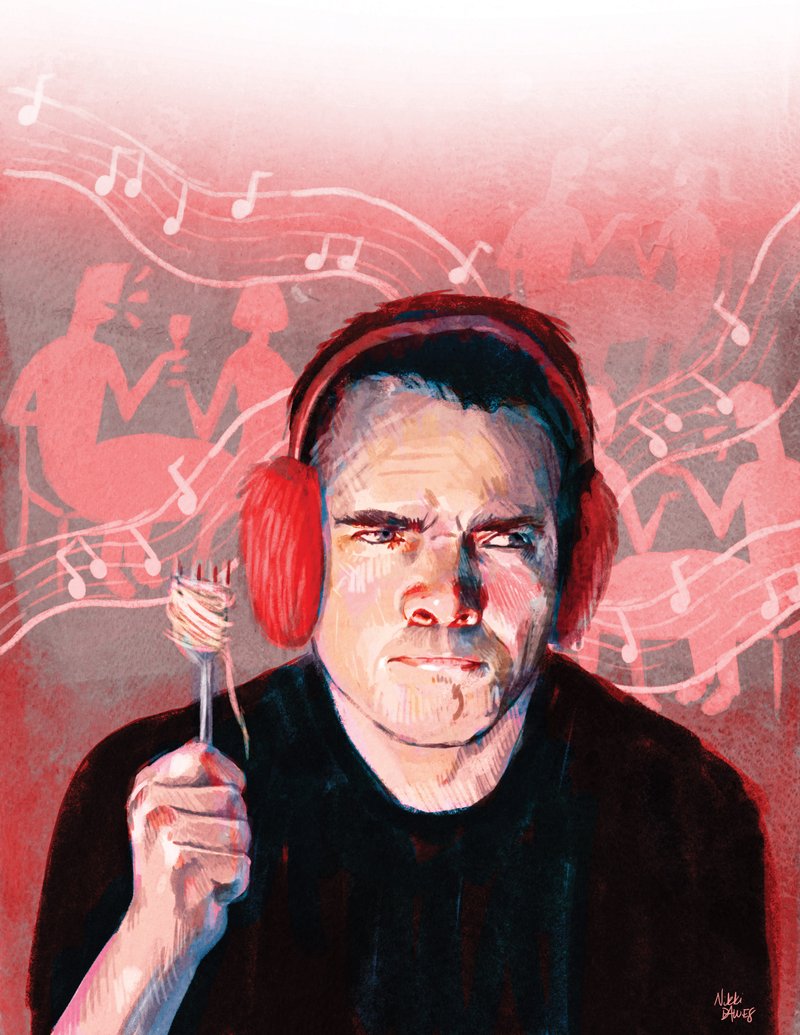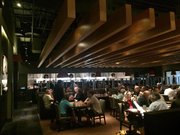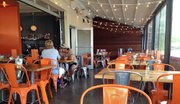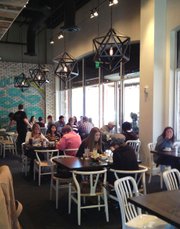It is generally accepted in the hospitality trade that a certain level of noise indicates a restaurant is successful. Meanwhile, one of the most frequent complaints restaurant owners (as well as restaurant writers and food bloggers) receive about folks' restaurant experiences is that the place at which they just ate is just too darn noisy.
That, for example, has been the rap on the recently opened Heights Taco & Tamale in Little Rock, the latest establishment from Yellow Rocket Concepts, which also created and operates Local Lime, two Big Orange restaurants and Lost Forty Brewery in Little Rock, and Little Rock and Conway branches of ZaZa Fine Salad & Wood Oven Pizza Co.
Yellow Rockets' creative director Amber Brewer, who has been involved in the creation of seven Yellow Rocket establishments, says when she's building up a restaurant, literally and figuratively, from the ground floor, sound and acoustic design comes late in the process. And she admits that isn't her area of expertise.
"We have partners in AV [audio-visual], so we have people who come in and design where our speakers go," she says. And finishing touches on each restaurant affect the sound level and quality.
"In Big Orange we have a lot of acoustic paneling, and it matches the carpet," she says. "Local Lime is half carpeted, half not carpeted. Big Orange Midtown sounds great; it gets a little loud if it's completely full, with raucous bar stuff at night.
"With higher ceilings comes more noise, and also with busy restaurants -- and our restaurants are usually pretty full. When you have a spot with [an] eight- to 12-foot acoustic-tiled ceiling with carpet, that's naturally going to be a softer environment. When you have a warehouse -- Lost Forty is a warehouse -- it has metal ceilings, it has concrete floors. Sometimes it gets a little loud in there, but it's a brewery. It would be really weird if it were quiet.
"We try to let the space be the space, which I think is part of the success of our restaurants. We strive to create an environment rather than covering everything up."
Several factors have affected the noise level at Heights Taco & Tamale, some of which, she says, are in the process of getting fixed.
Most of the issues involved rebuilding in an existing footprint -- originally and for
more than six decades, it was Browning's. Then a Houston restaurant group bought it and redesigned it as a big, open, and very noisy space.
"That building was in terrible shape," Brewer says. "And everything [her predecessors] did pushed it in the wrong direction. And we had some issues with the building in not being able to do some of the design work we wanted to do."
Fixing the noise level, "that was kind of on me and my sound guys. But every time we went to do something, another part of the building fell apart.
"That building is so old, to actually fix all the problems with it, we'd have to dig into the facade, and we didn't want to do that -- we're not going to change it, we wanted it to [still] be classic Browning's, so we're trying to do it slowly."
The first priority, she says, was repairing the building's classic, but leaky, tile roof. That's being worked on for a few months at night, every other week, two or three times a week.
"We were supposed to be able to drop in some paneling into the ceiling; it wasn't going to be [installed] on time [for the restaurant's April opening], but it was supposed to help. So we have to wait until the roof is done before we can put the paneling in. But that's actually going to be finished by the end of November."
Until then, the dining experience there will continue to be chain-restaurant noisy.
"It's real 'ringy' right now, especially since it's so crazy busy," she says.
HIGH VOLUME
The noise level in restaurants has a major economic factor, says Cornell University's Stephani K.A. Robson, in a 1999 university publication, "Turning the Tables: The Psychology of Design for High-Volume Restaurants."
"To increase the volume of sales, one needs to expand that inventory by increasing the number of available seats," Robson explains. "Owing to the physical constraints of most restaurants, adding seats is not feasible. That leaves only one good way to increase the inventory: turning tables more rapidly."
Guests are going to find sound volume as detracting from "the enjoyment of their experience," so "care should be taken ... to ensure that the volume in a restaurant is sufficient to provide a moderately high level of arousal (resulting in fast turnover) but not so much that it prevents comfortable conversation (thereby discouraging repeat patronage and positive word-of-mouth promotion)."
And in a PowerPoint demonstration for his students at the School of Tourism & Hotel Management at Bilkent University in Ankara, Turkey, Oguz Benice explains that "The sounds of a restaurant are part of its atmosphere. Kitchen noises, customer voices (talking, laughing), traffic noises and dish bussing all add to the atmosphere.
"Noise in a dining area is not always undesirable. People who work in quiet places, or are lonely, may seek out noisy restaurants. Business people will sometimes seek a noisy restaurant to conduct business so they will not be overheard. A noisy surrounding can create a special atmosphere which sets people at ease and stimulates people and makes them eat faster."
However, he says, it's important in establishing a restaurant's sound patterns that you know your customers' needs.
"A good music system, proper musical selection and proper volume have a positive effect on the success of a restaurant. An inadequate sound system can be a major factor in the failure of a restaurant. The correct type of background music (slightly louder than the ambient sound) puts customers in a good mood and helps make the staff more relaxed and efficient.
"Care should be taken to ensure that the volume ... is sufficient to result in a fast turnover but not so much that it prevents comfortable conversation."
And Bridget Moloney, in a 2010 article for Bon Appetit magazine, titled "3 Reasons Why Restaurants Are So Loud" (tinyurl.com/q7fxtza) references these previous findings by George Prochnik in The Daily Beast:
"1. Loud restaurants draw people in. Restaurateurs have found that louder restaurants are perceived as lively and successful. Very few people want to socialize in a silent room. If you're going out to drinks and dinner (and you are not a monk), you want to go somewhere fun, somewhere with energy. And nothings says 'fun' like a pounding bass line. Loud spaces are more attractive to customers.
"2. Modern design trends amplify the noise. Think unfinished spaces and naked tables. As Prochnik writes, 'We chow down in spaces evocative of an Industrial Revolution sweatshop, or a family run slaughterhouse. Somewhere along the way, we began thinking of tablecloths, carpets and soft ceilings as signs of weakness.' Without any textiles on the tables or floors, sound is unabsorbed and free to bounce around the space and directly into our ears.
"3. Loud music makes us 'drunk.' There's scientific proof that the louder and faster the music, the faster (and often more) people eat and drink. In the past, corporate restaurant chains have even developed soundtracks that switch to higher tempo music at a louder volume when they want to turn tables."
ONE CHAIN'S DESIGN
Bill Martens, vice president of development and construction for Del Frisco's Restaurant Group, which just opened a Del Frisco's Grille on Chenal Parkway in west Little Rock, says the layout for each of their restaurants is unique, and they're constantly experimenting with new materials and lighting to produce what he calls "a warm and comfortable feel."
"Sound is something that we're focused on," he says. "By and large we're careful and cognizant of the sound level in the restaurant; we want the music to be background and not to dominate. It's got a nice feel to it and creates a nice energy.
"There's ambient noise, but at the same time we're sensitive to the noise that you'd hear in the dining room in particular, so we do employ a number of acoustical sound treatments, some sound attenuation-type products. We'll use textured ceiling panels in certain locations; in others we'll spray an acoustical spray on the ceiling.
"But we don't go overboard in terms of sound attenuation. We're trying to strike a nice balance between having a nice energy and vibe and having it be too loud to carry on a conversation. That's something we're cognizant of and go to great lengths to get to that appropriate level."
(The new west Little Rock Del Frisco's separates the somewhat noisy bar area from the dining spaces -- a covered patio, two "stripes" of tables and booths, one of which fronts the open kitchen -- with glass-topped dividers. Wooden ceiling beams spanning the dining spaces, in addition to their aesthetic appeal, also serve to break up sound. Table conversations were possible at a slightly elevated level but we did find ourselves having to shout a little to the waiter.)
"We do have an audio-visual systems in all our locations," Martens says. "There are different stations with keypads that one of the managers or staff can utilize; for the bar, patio, dining room, restrooms, they're able to set a mood with the music system. We're not a sports bar by any means, but we offer televisions at the bar and in the patio for sports events."
There's a chainwide music play list. "We have a customized music list that for the most part is consistent across locations," Martens says. "It comes on a music player that we purchase from a vendor and it comes preprogrammed, but the manager does have the capacity to make slight modifications," and control of the volume level through monitoring guest feedback. "That's a core part of the ambience for us."
Martens says that unlike some chains, his doesn't overtly focus on using sound levels to turn tables quickly.
"No, we don't attempt to do that. We have comfortable seating and we want guests to feel comfortable," he says. The staff is trained to accommodate folks who want a quick meal, but it's OK to linger.
Nor is turning tables a design priority for Yellow Rocket, Brewer says.
"I never thought of that before," she says. "I guess that's a good point, [but] we're just not into that.
"My focus is on designing a space that is conceptually about the food at its core and about having a good time. At Local Lime, we turn tables every hour and a half. People like to sit and enjoy, and that's OK with us.
"We don't hustle people out the door; people enjoy themselves."
Style on 10/11/2015




